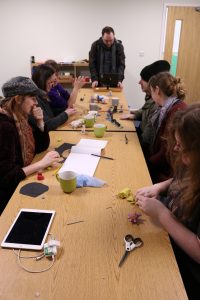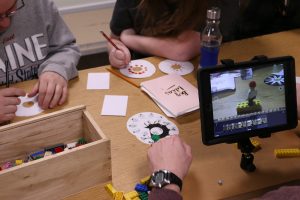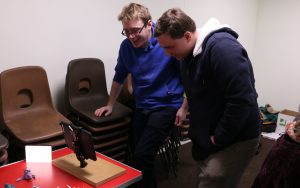
This was the first workshop of six that we are running at the NAS Lynx Centre in Weston Super Mare as part of the Exploring Diagnosis project.
Last time we were here we had workshops for larger groups of people, perhaps 20 at once, and we set up simultaneous activities like a green screen, iPads and modelling clay for animation.
This time, Dom (workshop leader) and Lena (the centre manager) discussed smaller groups for people who expressed an interest in animation.
Dom writes
“As in previous workshops we had a box of plasticine (modelling clay) and a pair of iPads with an animation app installed. Everyone enjoys making things with plasticine and a couple of people really took well to animating.
Often I find with people new to animating that there aren’t enough frames in the animation. It all goes by too quickly. The animators don’t usually mind this as they can see the elements they expected on screen but for anyone else it is difficult to see what is meant. This is one of the reasons I was particularly impressed with the Pokemon animation which rolls on to the screen, gets poked and then fills the screen with a cloud of black ink. The pacing is very good. Jess asked for advice and then used it.
People are often reluctant to re-do a thing that isn’t right the first time because “it took ages”, though the “ages” in question are usually between 5 and 10 minutes. I’m hoping to get to the point where the animators are happy to look at what they’ve done and if it isn’t quite how they hoped perhaps make it again, taking into account what they’ve learnt.
 This week I brought some reference cards and foldover clips along and flipbooks were made. I had several examples which were eagerly thumbed through. Only a couple of people really got into flipbook making but I’ll bring more supplies next week and I think other people will come around to it. I think it might seem a bit of a daunting task as there is a fair amount of drawing involved. Really you need at least 20 pages to get a good flip on the go and you have to draw every page from scratch so it isn’t like stop motion where you can just move a thing and take a picture.
This week I brought some reference cards and foldover clips along and flipbooks were made. I had several examples which were eagerly thumbed through. Only a couple of people really got into flipbook making but I’ll bring more supplies next week and I think other people will come around to it. I think it might seem a bit of a daunting task as there is a fair amount of drawing involved. Really you need at least 20 pages to get a good flip on the go and you have to draw every page from scratch so it isn’t like stop motion where you can just move a thing and take a picture. This week I brought some reference cards and foldover clips along and flipbooks were made. I had several examples which were eagerly thumbed through. Only a couple of people really got into flipbook making but I’ll bring more supplies next week and I think other people will come around to it. I think it might seem a bit of a daunting task as there is a fair amount of drawing involved. Really you need at least 20 pages to get a good flip on the go and you have to draw every page from scratch so it isn’t like stop motion where you can just move a thing and take a picture.
This week I brought some reference cards and foldover clips along and flipbooks were made. I had several examples which were eagerly thumbed through. Only a couple of people really got into flipbook making but I’ll bring more supplies next week and I think other people will come around to it. I think it might seem a bit of a daunting task as there is a fair amount of drawing involved. Really you need at least 20 pages to get a good flip on the go and you have to draw every page from scratch so it isn’t like stop motion where you can just move a thing and take a picture.


